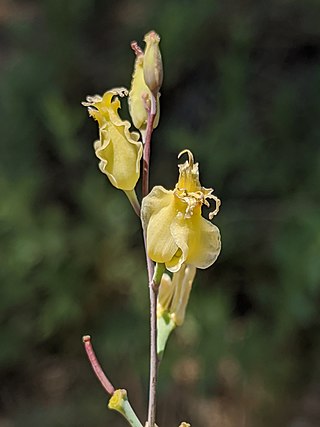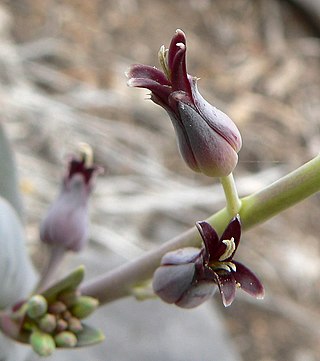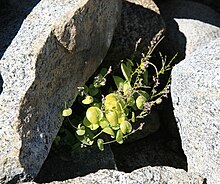
Pyrrocoma apargioides is a species of flowering plant in the family Asteraceae known by the common name alpineflames. It is native to the western United States from the Sierra Nevada of California east to Utah, where it grows in the forests and meadows of high mountains. It is a perennial herb growing from a taproot and producing one or more stems to 30 centimeters in length. The stems are decumbent or upright, reddish, and hairless to slightly woolly. Most of the leaves are located around the base. They are thick and leathery, lance-shaped with large sawteeth along the edges, often center-striped in white, and measure up to 10 centimeters long. The inflorescence is usually a single flower head lined with centimeter-long phyllaries which are reddish to green with red edges. The head has a center of yellow disc florets and a fringe of ray florets which are yellow, often splashed with red along the undersides, measuring up to 1.6 centimeters in length. The fruit is an achene which may be well over a centimeter in length including its pappus.

Rudbeckia californica is a species of flowering plant in the family Asteraceae, known by the common name California coneflower.
Sedum radiatum is a species of flowering plant in the family Crassulaceae known by the common name Coast Range stonecrop. It is native to Oregon and California, where it is known from several coastal and inland mountain ranges, including the Klamath Mountains and the Sierra Nevada. It grows in many types of rocky habitat, sometimes on serpentine soils. It is an annual or biennial succulent plant producing several stems with elevated, somewhat basal rosettes of leaves. The leaves are not much more than a centimeter long. They are green or yellowish with green, purple or red veining. The inflorescence is a short, erect array of many densely packed flowers. The flowers have yellow, cream, or white petals which are lance-shaped and one half to 1 centimeter long.

Streptanthus longirostris is a species of flowering plant in the family Brassicaceae, which is known by the common name longbeak streptanthella, or simply streptanthella. It is native to western North America, where it occurs throughout the western United States and the northwestern states of Mexico. It grows in many types of habitat, including deserts, sagebrush, foothill woodlands, sandy flats, chaparral, and scrubby canyons.
Streptanthus barbatus is a species of flowering plant in the mustard family known by the common name Pacific jewelflower. It is endemic to the southern Klamath Mountains of far northern California, where it occurs in open wooded habitat among Jeffrey Pines, generally on serpentine soils. It is a perennial herb producing a decumbent or erect, sometimes branching stem up to 70 to 90 centimeters long. It is hairless except for some light hairs on the flowers and the bases of the leaves. The largest leaves are at the base of the plant. They are oval with faintly toothed, bristly edges and borne on short petioles. Leaves above these are oval to rounded and may clasp the stem. Flowers occur at intervals along the upper stem. Each has a spherical to urn-shaped calyx of keeled sepals under a centimeter long with curving petals barely emerging from the tip. The calyx of sepals is whitish, darkening purple in maturity. The petals are purple. The fruit is a long, flat, curving silique which may be 7 centimeters in length.
Streptanthus barbiger is a species of flowering plant in the mustard family known by the common name bearded jewelflower. It is endemic to California, where it is limited to the North Coast Ranges. It grows in woodlands and chaparral habitat, often on serpentine soils. It is an annual herb producing a branching stem up to about 80 centimeters in maximum height. Leaves near the base of the stem are lance-shaped to oval and pointed, usually with toothed edges, the blades measuring up to 7 centimeters long. Leaves higher on the stem may be longer but are narrower and have smooth edges. Flowers occur at intervals along the upper stem. Each has a spherical to urn-shaped calyx of greenish yellow or purple sepals under a centimeter long. Whitish or purple-tinged petals up to a centimeter long emerge from the tip. The fruit is a long, flat, curving silique which may be 7 centimeters in length.

Streptanthus bernardinus is a species of flowering plant in the mustard family known by the common name Laguna Mountains jewelflower, or Laguna Mountain jewelflower.
Streptanthus campestris is a species of flowering plant in the mustard family known by the common name southern jewelflower. It is native to southern California and northern Baja California, where it is known from fewer than 20 occurrences scattered between San Bernardino County, California, and Sierra de San Pedro Mártir in northern Baja. It grows in mountain chaparral, woodlands, and forests, at elevations up to 2300 meters. It is a perennial herb producing a thick, few-branched stem up to 1.5 meters tall or more. The basal leaves have fleshy oval blades with bristly, toothed edges which are borne on petioles. Leaves farther up the stem are lance-shaped with smooth or wavy edges and bases that clasp the stem. Flowers occur at intervals on the upper stem. Each has a bell-shaped calyx of bristle-lined purple sepals with four purple tipped yellow petals emerging from the tip. The fruit is a narrow, curving or straight silique which may reach 14 centimeters in length.

Streptanthus cordatus is a species of flowering plant in the mustard family known by the common name heartleaf twistflower. It is native to the western United States, where it can be found in many types of sagebrush, woodland, and forest habitat. It is a perennial herb producing a branched or unbranched stem up to about a meter tall. It is often waxy in texture. The basal leaves are oval or spoon-shaped with bristle-toothed blades borne on rough-haired petioles. Leaves higher on the stem are oval to lance-shaped, up to 9 centimeters long with their bases usually clasping the stem. Flowers occur at intervals along the upper stem. Each has a calyx of sepals roughly a centimeter long which begin greenish yellow and mature purple. Four purple petals emerge from the tip of each calyx. The fruit is a thin, narrow silique which may reach 14 centimeters in length or longer.
Streptanthus farnsworthianus is an uncommon species of flowering plant in the mustard family known by the common name Farnsworth's jewelflower. It is endemic to California, where it is limited to the woodlands of the Sierra Nevada foothills. It is an annual herb producing a hairless, waxy, purple or purple-tinged stem up to half a meter tall or more. The ephemeral basal leaves have blades up to 15 centimeters long which are each divided into several narrow lobes or leaflets. Leaves higher on the stem have purple lance-shaped blades that generally clasp the stem at their bases. Flowers occur at intervals along the upper stem with one or two leaflike purple bracts at the base of the raceme. Each flower has an urn-shaped calyx of purple sepals up to a centimeter long. Curling purple-veined white petals emerge from the tip of the calyx. The fruit is a straight or curving silique up to 12 centimeters long.
Streptanthus fenestratus is an uncommon species of flowering plant in the mustard family known by the common name Tehipite Valley jewelflower.
Streptanthus gracilis is an uncommon species of flowering plant in the mustard family known by the common name alpine jewelflower.
Streptanthus howellii is an uncommon species of flowering plant in the mustard family known by the common name Howell's jewelflower. It is endemic to the Klamath Mountains of southern Oregon and northern California. It grows in mountain forests on serpentine soils. It is a perennial herb producing a hairless, often waxy-textured stem up to 70 or 80 centimeters in maximum length. It is generally unbranched. The ephemeral basal leaves have fleshy oval blades with smooth or toothed edges, borne on petioles. Leaves farther up the stem are similar but smaller and narrower, with shorter petioles or none. They do not clasp the stem. Flowers occur at intervals along the upper stem. Each has a calyx of purple sepals under a centimeter long with purple-tipped yellow petals emerging from the tip. The fruit is a thin, smooth, curved silique up to 12 centimeters long.
Streptanthus insignis is an uncommon species of flowering plant in the mustard family known by the common names plumed jewelflower and San Benito jewelflower. It is endemic to California, where it is known only from the Inner Central Coast Ranges. It grows in grassland and chaparral habitat, usually on serpentine soils. It is an annual herb producing a hairy, bristly, branching stem up to about 60 centimeters long. The lance-shaped basal leaves are borne on short petioles. Leaves midway up the stem are longer, and those near the top are shorter. They sometimes clasp the stem at their bases. Flowers occur at intervals along the upper stem. The uppermost flowers are often sterile and different in form. Each fertile flower has a bell-shaped calyx of sepals which is purple or greenish-yellow depending on subspecies. The petals at the tip are purplish or yellowish, also depending on subspecies. The fruit is a flat, straight silique which may be over 11 centimeters long.

Streptanthus longisiliquus is a species of flowering plant in the mustard family known by the common name long-fruit jewelflower. It was first described to science in 2007. It is endemic to northern California, where it is known from Butte, Tehama, and Shasta Counties. It can be found in forest and woodland habitat in mountains and foothills. It is a short-lived perennial herb producing a few-branched stem up to 1.2 to 1.5 meters in maximum height. It is mostly hairless except for some light hairs on the inflorescences and sometimes the leaf petioles. The basal leaves have oval or spoon-shaped blades up to 10 centimeters long, usually with smooth edges. Leaves higher on the stem are oval or oblong and lack petioles, their bases often clasping the stem. Flowers occur at intervals along the upper stem. Each flower has a bell-shaped calyx of sepals which yellow-green at the base and purplish at the tip, measuring under a centimeter in length. The petals emerging from the end are brownish or purplish with greenish bases. The fruit is a flattened, curving silique that can be quite long even for the genus, measuring up to 15 centimeters in length.
Streptanthus morrisonii is an uncommon species of flowering plant in the mustard family known by the common name Morrison's jewelflower. It is endemic to California, where it is known from the North and Central Coast Ranges. It is limited to serpentine soils in chaparral and forest habitat. It is considered a species complex which includes Streptanthus brachiatus. S. morrisonii is divided into four subspecies and is variable. In general, it is a biennial herb producing a hairless, waxy stem up to 1.2 to 1.5 meters in maximum height, often branching at the tip. The basal leaves have fleshy, lance-shaped blades 3 to 5 centimeters long borne on petioles. The blades are gray-green on the upper surface and purple or purple-mottled underneath. Leaves higher on the stem are variable in shape and become smaller toward the top of the plant. Flowers occur at intervals along the upper stem. Each has an urn-shaped calyx of keeled sepals in shades of yellow-green to purple. The petals emerging from the tip are whitish with purple-brown veining. The fruit is a flattened straight or slightly curved silique up to 8 centimeters long.

Streptanthus oliganthus is an uncommon species of flowering plant in the mustard family known by the common name Masonic Mountain jewelflower. It is native to western Nevada and eastern California, where it grows in the rocky hills east of the central Sierra Nevada. Its habitat includes forest, woodland, sagebrush, and mountain talus. It is a rhizomatous perennial herb producing a hairless, waxy, usually unbranched stem up to about 40 or 50 centimeters in maximum height. The basal leaves have lance-shaped, smooth-edged blades up to 10 centimeters long borne on fuzzy to rough-haired petioles. Leaves higher on the stem have shorter blades which may clasp the stem at their bases. Flowers occur at intervals along the upper stem. Each has a bell-shaped calyx of purple sepals no more than a centimeter long. The petals emerging from the tip are reddish purple or purple-tipped. The fruit is a smooth, flat, straight or slightly curved silique up to 8 to 10 centimeters long.
Thelypodium crispum is a species of flowering plant in the mustard family known by the common name crisped thelypody.

Triteleia dudleyi is a species of flowering plant known by the common name Dudley's triteleia. It is endemic to California, where it is known from sections of the High Sierra Nevada and the Transverse Ranges. It is a plant of subalpine climates, growing in mountain forests. It is a perennial herb growing from a corm. It produces two or three basal leaves up to 30 centimeters long by one wide. The inflorescence arises on an erect stem up to 30 or 35 centimeters tall and bears an umbel-like cluster of many flowers. Each flower is a funnel-shaped yellow bloom that dries purple. The flower has six lobes measuring up to 1.2 centimeters long. There are six stamens with lavender anthers.

Streptanthus bracteatus is a species of flowering plant in the mustard family known by the common names bracted jewelflower and bracted twistflower. It is endemic to Texas in the United States.









